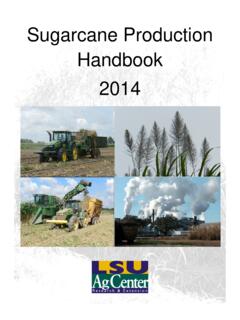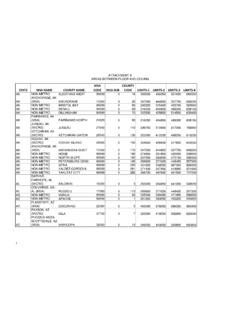Transcription of What Is Soil Electrical Conductivity?
1 1 LSU agcenter Pub. 3185 what Is soil Electrical Conductivity? what Is soil Electrical conductivity ? Electrical conductivity is an indirect measurement that correlates very well with several soil physical and chemical properties. Electrical conductivity is the ability of a material to conduct (transmit) an Electrical current and it is commonly expressed in units of milliSiemens per meter (mS/m). Alternatively, Electrical conductivity measurements can be expressed in deciSiemens per meter (dS/m), which is 100 times greater than milliSiemens per meter. Figure 1. conductivity values of different soil can soil Electrical conductivity be measured?There are two different types of sensors that can measure Electrical conductivity a contact sensor and a noncontact sensor. Veris Technology manufactures a contact Electrical conductivity sensor. There are several models available that provide Electrical conductivity measurements at single depths or at two different depths.
2 Contact sensors have to make soil contact to measure Electrical conductivity . Usually, two to three pairs of coulters are used. One pair provides Electrical current to the soil while the others measure the voltage drop between them and use that drop to calculate Electrical conductivity . Contact sensors usually measure soil Electrical conductivity in two different depths, shallow (1 foot) and deep (3 feet).Figure 2. A contact soil Electrical conductivity measuring also are noncontact Electrical conductivity sensors that work on the principle of electromagnetic induction. An electromagnetic induction sensor does not have to contact the soil directly. The electromagnetic induction method is based on the measurement of the change in mutual impedance between a pair of coils on or above the soil s surface. Most electromagnetic induction instruments are comprised of two or more sets of coils. These coils are electrically connected and are separated by a fixed distance.
3 The transmitter coil (primary field) is used to generate an electromagnetic field at a specific frequency. This causes Electrical currents to flow in conductive materials in the subsurface. The flow of currents in the subsurface, called eddy currents, generate a secondary magnetic field, which is sensed by the receiver coil. The magnitude of the secondary field sensed by the receiver depends upon the type and distribution of conductive material in the subsurface. Both the induced secondary field and the primary field are detected at the receiver such as Geonics, Aeroquest Sensortech and Geophysical Survey Systems offer several models of noncontact electromagnetic induction sensors. 2 LSU agcenter Pub. 3185 what Is soil Electrical Conductivity? Noncontact Electrical conductivity sensors typically have greater measurement depth than contact sensors. Figure 3. Electromagnetic induction measures soil Electrical conductivity using noncontact can Electrical conductivity be used in precision agriculture?
4 Farmers using precision farming technologies can use Electrical conductivity measurements to create spatially dense datasets to describe soil variability within a field efficiently and Electrical conductivity sensor coupled with a GPS receiver typically can generate 50 Electrical conductivity samples per acre when pulled at a ground speed of 10 mph and 60 feet spacing per pass. This is a much denser dataset than grid soil sampling (usually one sample every acres). It is possible to produce a greater resolution soil map than with a typical nutrient map. Mapping at this density will identify soil inclusions that are a quarter-acre in size or Electrical conductivity and crop yield mapsCommercial operators are using Electrical conductivity to provide soil variability information to producers. Often, however, the tendency is to relate Electrical conductivity maps directly to crop yield maps. This approach may backfire depending on the moisture regime for any given year.
5 Typically, in areas with contrasting drainage classes, correlations between Electrical conductivity and grain yield can vary from strongly correlated to not significant, depending on whether or not the year was a wet or dry year. A more thorough approach is to first relate Electrical conductivity data to soil profile properties and then relate soil variability and climatic conditions to yield. what type of soil properties does soil Electrical conductivity correlate to?Since sands have low conductivity and clays have high conductivity , soil Electrical conductivity correlates very strongly with particle size and soil texture. Soils prone to drought or excessive water will show variations in soil texture that can be delineated using soil Electrical water-holding capacity is intimately linked to crop yields, there is enormous potential to use soil Electrical conductivity measurements to delineate areas with different yield potential. soil Electrical conductivity also can delineate differences in organic matter content and cation exchange capacity (also known as Celectrical conductivity ).
6 Perhaps the greatest difficulty with a measurement as inclusive as soil Electrical conductivity is to conclude what is causing the variation seen in soil Electrical conductivity in any given area. Is it nutrient variation or deficiency, or is it just soil texture?Using soil Electrical conductivity to create zones with different management strategies is becoming very popular. Areas are grouped by similar Electrical conductivity values and may respond similarly to different management systems. Table 1 (page 3) shows different uses of Electrical conductivity management for nematodes in cottonA good illustration of how this technology is being used is its application in the management of nematode problems in cotton. The Southern root-knot nematode (Meloidogyne incognita) seems to prefer coarse-textured, sandier soils. In addition, the greatest damage occurs in soils with the greatest percentage of sand and from the only a few nematodes. As the percentage of sand decreases, it takes more nematodes to cause problems.
7 Increasing clay content also can reduce nematode injury. 3 LSU agcenter Pub. 3185 what Is soil Electrical Conductivity? Since many fields have variable soil texture and Southern root-knot nematode occurring in only parts of the field, these fields can be divided up into management zones based on using Electrical conductivity data. Figure 4 shows a field that has been divided into a number of zones based on Electrical conductivity collected in the fall. This same field was also extensively sampled for nematodes and shows the relative population levels of Southern root-knot nematodes throughout the field. Southern root-knot nematodes were found at high populations in the Electrical conductivity zones that had the lowest readings. Based on where the nematodes occurred in the field, management zones could be created for site-specific application of nematicides. The field could then be divided into the area requiring treatment (colored red) and area where nematicides would not be needed (colored green).
8 Using soil Electrical conductivity to help manage weed resistanceWeed resistance to glyphosate is occurring in most of the southern states. Different herbicide strategies will be required to combat glyphosate-resistant weeds. Pre-plant incorporated herbicides and pre-emergence herbicides most likely will be used in a herbicide rotation to manage glyphosate-resistant weeds. Rates for soil -applied herbicides usually are based on soil texture. Soils with high organic matter content or high clay content are given higher rates of soil -applied herbicides. Both soil texture and clay content can be defined by Electrical conductivity measurements. Electrical conductivity maps easily can be converted into variable-rate maps for the application of pre-plant incorporated herbicides or pre-emergence use of Electrical conductivity mapsSoil properties estimatedDelineation of management zonesSoil texture, organic matter, Celectrical conductivity , plant-available water contentDirected soil sampling within more accurate soil boundariesSoil texture, organic matter, Celectrical conductivity , drainage issuesVariable rate seedingCelectrical conductivity , topsoil depthVariable rate nutrient application based on soil productivitySoil texture, depth to claypanVariable rate herbicide applicationSoil texture, organic matter, Celectrical conductivityYield map interpretationSoil factors influencing crop yieldSite specific application of nematicide in cottonSoil textureTable 1.
9 Different Uses of Electrical conductivity MeasurementsFigure 4. Field divided into six Electrical conductivity zones with populations of Southern root-knot nematodes present in the field. Since high levels of these nematodes are present in only the two zones with the lowest Electrical conductivity readings, only these two areas would be included for treatment with a LSU agcenter Pub. 3185 what Is soil Electrical Conductivity? REFERENCESA eroquest Sensor Technologies at , T., Kitchen, , and Lund, Site-Specific Management Guidelines: soil Electrical conductivity Mapping. Potash and Phosphate Institute (PPI). Publication No. , R. and M. Sullivan. soil Electrical conductivity ( Electrical conductivity ) Sensors. Ohio State University Extension. Limited at Survey Systems at , R., Alley, M., Holshouser, D., Thomason, W. Precision Farming Tools: soil Electrical conductivity . Virginia Cooperative Extension. Publication No. , C., E. Burris, Cook, McGawley, Padgett, and Wolcott.
10 2006. Identifying root-knot nematode areas in cotton using soil Electrical conductivity . P053, Proceedings of the 5th National IPM Symposium, Sudduth, , Kitchen , Wiebold, W. J., Batchelor, , Bollero, , Bullock, , Clay, , Palm, , Pierce, , Schuler, , Thelen, 2005. Relating apparent soil Electrical conductivity to soil properties across the north-central USA. Computers and Electronics in Agriculture. 46(2005)263-283. Technologies at , P., Khalilian, A., Mueller, J., Henderson, W. 2009. Applications of soil Electrical conductivity in Production Agriculture. Better Crops Magazine. Vol. 93 (2) N. Barbosa, ProfessorDepartment of Biological and Agricultural Engineering LSU AgCenterCharles Overstreet, Ph. of Plant Pathology and Crop Physiology LSU AgCenterLouisiana State University Agricultural CenterWilliam B. Richardson, ChancellorLouisiana Agricultural Experiment StationJohn S. Russin, Interim Vice Chancellor and DirectorLouisiana Cooperative Extension ServicePaul D.















